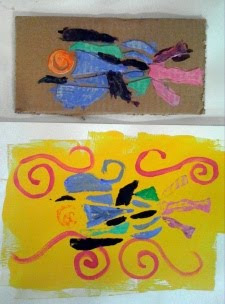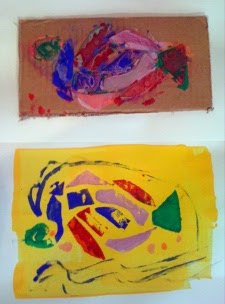

The yellow pieces in the above photos are the finished work. The art above is the cardboard with the flexi-cut pieces on top that the students created to print.
DISCUSSION: printmaking: what is it? Why is it so important in art?
Complimentary colors and value are very important in today’s artwork
Look at the artwork of Vincent Scarpace:
What do you think
What is he inspired by?
What do you see first in the work?
What about the colors he used?
J. Vincent Scarpace
1971-
American Artist
Born: Buffalo, New York
DISCUSSION: printmaking: what is it? Why is it so important in art?
Complimentary colors and value are very important in today’s artwork
Look at the artwork of Vincent Scarpace:
What do you think
What is he inspired by?
What do you see first in the work?
What about the colors he used?
J. Vincent Scarpace
1971-
American Artist
Born: Buffalo, New York
His original works are “a personal journey through the use of basic of art elements: line, shape, and color - resulting in an arrival, just past experimentation, at unique works of art which purposely resemble fish.”
He’s followed his passion for the creative process, the pursuit of one’s own creative potential.
J. Vincent knew from an early age exactly what he wanted to do with his life.
encouraged from about age 2 to pursue line, shape, and color, and the creation of art.
J’s mother, an artist in her own right, taught young J. Vincent how to enjoy drawing, painting, and sculpture very early on.
Having worked as an apprentice, production artist, and studio artist .
J. Vincent holds a BS in Education (Art and Education),
after several years of teaching in both private and public schools, he’s now a former teacher, "retired" very early, to his studio to continue his creative journey and drive toward the creation of unique works of abstract fish art. Today, J. Vincent Scarpace’s original works can be found in private and public collections in over 40 countries and in all 50 U.S. States.
He is currently in art galleries, in numerous restaurants, and in many corporate and professional collections. J. resides in College Station, TX
For additional artist information, please visit: http://www.ipaintfish.com/
PROJECT: Create a fish like our artist that we can print
Step1: paint a background for your fish with a brayer using one BRIGHT color Yellow is perfect
Step 2: begin to cut out pieces of your sticky foam and form it out your card board to create a fish. REMEMBER: place next to each other, NOT OVERLAPPING, like a mosaic
Step3: Start with the eye. a large circle or swirl
Step4: create a body frame by cutting out a smile and a frown. place them on top of each other creating an oval shape
He’s followed his passion for the creative process, the pursuit of one’s own creative potential.
J. Vincent knew from an early age exactly what he wanted to do with his life.
encouraged from about age 2 to pursue line, shape, and color, and the creation of art.
J’s mother, an artist in her own right, taught young J. Vincent how to enjoy drawing, painting, and sculpture very early on.
Having worked as an apprentice, production artist, and studio artist .
J. Vincent holds a BS in Education (Art and Education),
after several years of teaching in both private and public schools, he’s now a former teacher, "retired" very early, to his studio to continue his creative journey and drive toward the creation of unique works of abstract fish art. Today, J. Vincent Scarpace’s original works can be found in private and public collections in over 40 countries and in all 50 U.S. States.
He is currently in art galleries, in numerous restaurants, and in many corporate and professional collections. J. resides in College Station, TX
For additional artist information, please visit: http://www.ipaintfish.com/
PROJECT: Create a fish like our artist that we can print
Step1: paint a background for your fish with a brayer using one BRIGHT color Yellow is perfect
Step 2: begin to cut out pieces of your sticky foam and form it out your card board to create a fish. REMEMBER: place next to each other, NOT OVERLAPPING, like a mosaic
Step3: Start with the eye. a large circle or swirl
Step4: create a body frame by cutting out a smile and a frown. place them on top of each other creating an oval shape
Step 5: fill the inside of the fish with shapes
Step6: create gills and fins
Step7: create a mouth
Step8: paint your fish with all different colors REMEMBER to use colors OPPOSITE on color wheel from your background
Step9: print your fish onto your background
Step10: add dots, swirly fins, lines, and other details with a q-tip
MATERIALS:
Flexi cut by the yard available at dick Blick: http://www.dickblick.com/products/blick-flexi-cut-printing-plates/
Step6: create gills and fins
Step7: create a mouth
Step8: paint your fish with all different colors REMEMBER to use colors OPPOSITE on color wheel from your background
Step9: print your fish onto your background
Step10: add dots, swirly fins, lines, and other details with a q-tip
MATERIALS:
Flexi cut by the yard available at dick Blick: http://www.dickblick.com/products/blick-flexi-cut-printing-plates/
paint brushes Large and small
Cardboard
Cardboard
water
White tag board
Tempura paint
White tag board
Tempura paint
Q-tips

















